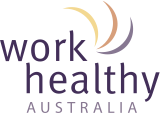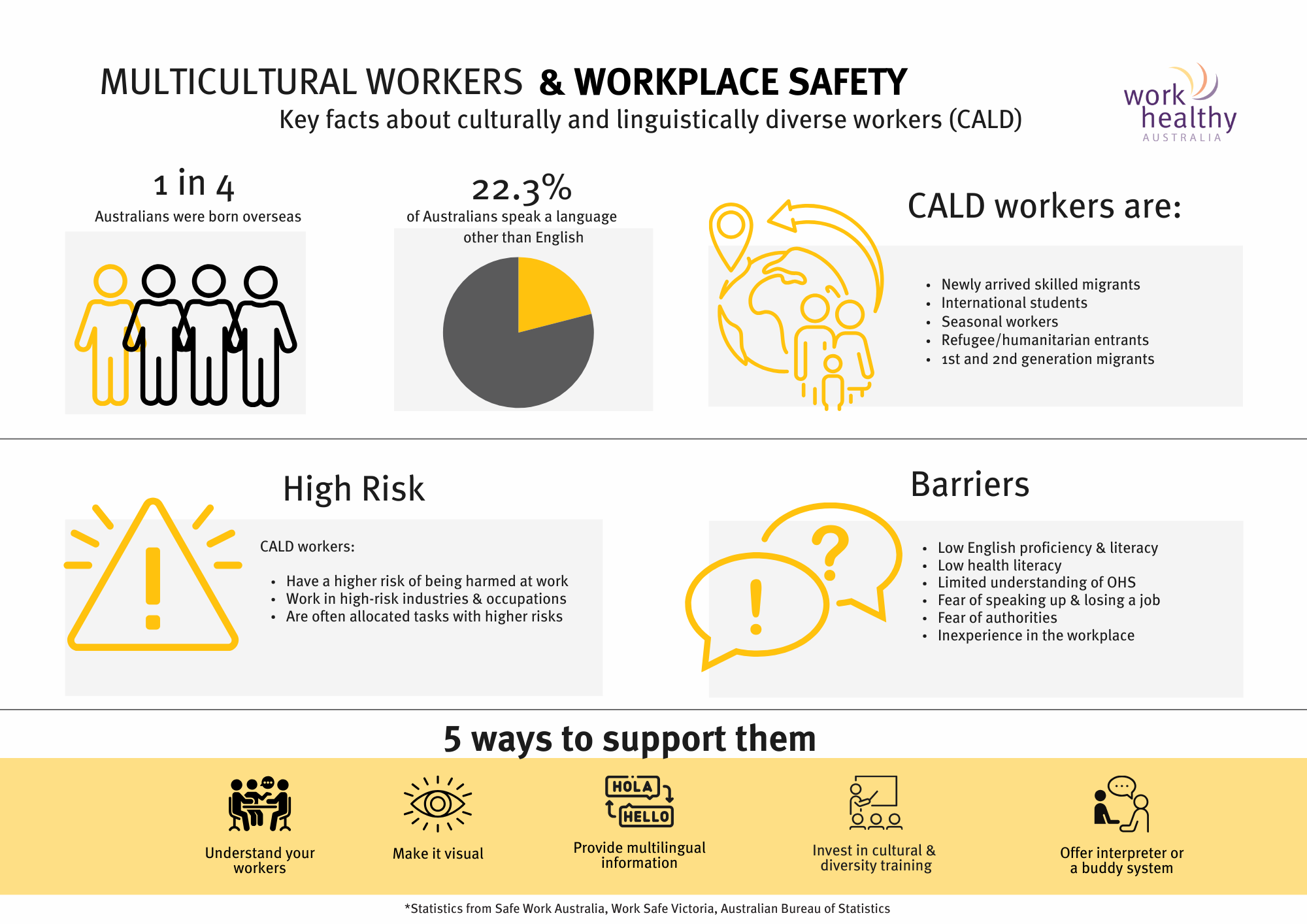
Diverse cultures, international communication concept. Human silhouette with speech bubbles.
We often speak with businesses who are struggling to engage their non-English speaking workers with workplace safety and on-site health services.
With a large proportion of manual handling workers being migrants or coming from multicultural backgrounds, it’s important to understand the barriers these workers face in participating in a safety culture and on-site injury management service.
According to Safework NSW, culturally and linguistically diverse (CALD) and migrant workers are more likely to be harmed in the workplace than other workers.
“Australian and international research states that CALD and migrant workers are concentrated, and over represented, in high-risk industries and occupations. When working in the same occupations, they are often allocated tasks with higher risks.”
CALD and migrant workers face a number of barriers to understanding and engaging in workplace safety. They may include:
- English language limitations, which hinder their understanding of work health and safety rights and worker obligations
- Low literacy, which hinders them accessing and understanding safety information
- Cultural norms, with might make some of them reluctant to speak up
- Limited understanding of safe work practices and on-site health services
- Inexperience in the job and/or at the individual workplace
- Fear of losing their job or visa, if they speak up about an injury or pain
Cultural case study – Filipino workers
One of our on-site Workplace Health Providers, Ruth, comes from a Filipino background and has treated many multicultural clients. She said that many Filipinos initially don’t understand what she does because, in their country, allied health providers such as osteopaths, chiropractors and physiotherapists are quite rare. The idea of on-site injury management services are foreign to them, as this concept doesn’t exist in the Philippines or other developing countries.
Although English might be a second language for some Fillipinos, often the Australian slang and occupational health terminology is complex and not fully understood. Ruth believes that culturally appropriate communication plays an important role in helping Fillipinos understand that their employer is on their side, and that the early intervention and injury management services provided on-site are there to help them.
“If the correct language and education is used, workers would be more likely to seek treatment, and will not feel ashamed or worried about losing their job,” says Ruth.
Cultural case study – Filipino workers
One of our on-site Workplace Health Providers, Ruth, comes from a Filipino background and has treated many multicultural clients. She said that many Filipinos initially don’t understand what she does because, in their country, allied health providers such as osteopaths, chiropractors and physiotherapists are quite rare. The idea of on-site injury management services are foreign to them, as this concept doesn’t exist in the Philippines or other developing countries.
Although English might be a second language for some Fillipinos, often the Australian slang and occupational health terminology is complex and not fully understood. Ruth believes that culturally appropriate communication plays an important role in helping Fillipinos understand that their employer is on their side, and that the early intervention and injury management services provided on-site are there to help them.
“If the correct language and education is used, workers would be more likely to seek treatment, and will not feel ashamed or worried about losing their job,” says Ruth.
So what can we do to support and engage our multicultural workers to understand workplace safety and to feel comfortable putting their hand up when they are sore? Below are some strategies that Work Healthy Australia has found successful:
1 – Invest in cultural training
Encourage supervisors, safety officers and managers to undertake cultural training. SBS has a handy website with information on a variety of cultures. You might also want to contact your state multicultural support organisation and migrant resource centres for support with improving cultural awareness at your workplace. Could you organise a simple event to celebrate an important day for your multicultural workers? For example, a carnival themed morning tea for Brazilian workers, or Lunar New Year for Vietnamese, or a Multicultural day, if you workers come from a variety of backgrounds.
2 – Provide multilingual information
Work Healthy Australia has information for workers available in Vietnamese and Chinese. We can work with you to develop safety information in other languages if there is a demand. State workplace safety authorities also have fact sheets available in languages other than English.
3 – Offer interpreting services or a buddy system
Arrange for an interpreter to be present when providing induction, manual handling training or other training to your workers. Promote the fact that workers can access interpreter services for their onsite health treatments. This might involve bringing a friend along to an appointment to act as interpreter, or using a work buddy who can provide language support.
4 – Make it visual
Many migrants and CALD workers working in manual handling jobs may have low literacy and numeracy skills, which means they might struggle with printed information, even in their own language. Whenever possible, use visual aids, illustrations and demonstrations to support your message. When talking, avoid using slang, acronyms or complex terminology without a full explanation of what it means.
5 – Get to know your workers
Encourage your onsite allied health provider to do floor walks and engage with workers. One of our providers learned basic conversation starters in Portuguese, a language spoken by a large contingent of Brazilians at the site where he works. He is able to say “hello”, “how are you”, “tummy down”, “tummy up” and other terms when treating the workers, making them understand and feel more comfortable with the treatment.
There are many ways to help your non-English and multicultural workers. Contact us to discuss how we can help your workers understand safety culture and better utilise your on-site health services.
Further Resources:
Speaking with clients who have low English proficiency – Centre for Culture, Ethnicity and Health
Translating and Interpreting Services – Australian Government Department of Home Affairs
Respect at Work – Creating safe, inclusive and respectful workplaces
WorkSafe ACT – Supporting culturally and linguistically diverse workers
Empowering and supporting a culturally diverse workforce – Centre for Cultural Diversity in Ageing
Sign up to our monthly enewsletter
"*" indicates required fields

